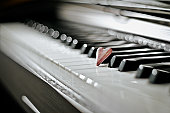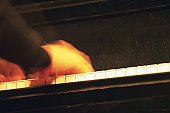
Home > Music Theory > Sight Reading
|
|||||
Rules for Good Sight Reading on Piano
In addition, many auditions often employ a sight reading section. Most songs that a piano player would be expected to sight read are not very difficult from a technical standpoint. In most cases, the only difficulty of sight reading is actually being able to play a song without learning it beforehand. The rules for good sight reading on piano are similar to most instruments. If you have to look at your hands while playing at any point, odds are you are never going to be able to sight read very well, if at all. Music notation is very dense and it is very easy to lose your place. Just glancing at the keyboard can be enough to completely throw you off. This can be an issue for more intermediate piano players that might still look at their hands out of reflex from when they were still beginners. Even when you are not sight reading, you should do your best to avoid looking at your hands if you do not need to. Some really complex piano parts do require most pianists to look at what they are doing, but you should try to break the habit of checking your hands, even when you know you do not need to do so.
Rather than trying to read and play each individual note, you are going to play a sequence of notes you have played before. Even if the song does not use many general musical constructs, it is still likely that the piano part repeats itself at some point. Looking for these repetitions serves a similar purpose. Do not get flustered by mistakes when sight reading. If you hit the wrong note, ignore it and play the next note normally. Do not try to go back and hit the note you originally meant to hit or stop playing. Most non-musicians or people unfamiliar with the song are not going to notice a wrong note. Most musicians know that mistakes are fairly common when sight reading and are not going to read much into it. However, if you try to go back and push the right note, you are going to place a note in the wrong place and most likely delay the next group of notes in the song. This type of mistake is very obvious to non-musicians and musicians alike. Stopping is also a bad idea for the same reason. The most important rule for good sight reading on piano is to practice. Sight reading is a skill that requires you to be able to quickly read and understand music notation and play that notation without any real effort. Both of these skills take time to develop. In addition, practicing is going to help you develop the ability to avoid getting flustered when mistakes do occur. The more time you practice sight reading, the easier it is going to be to perform. Check out this series of piano sight reading videos....
| |||||
|
Although every attempt has been made to make information as accurate as possible, we are not responsible for any errors that may appear.
 In many situations, a piano player can be handed sheet music and be expected to
play it purely through sight reading. This skill is commonly tested in examinations for piano performance.
In many situations, a piano player can be handed sheet music and be expected to
play it purely through sight reading. This skill is commonly tested in examinations for piano performance.
 Another rule for good sight reading on piano is to look for patterns. The
Another rule for good sight reading on piano is to look for patterns. The



